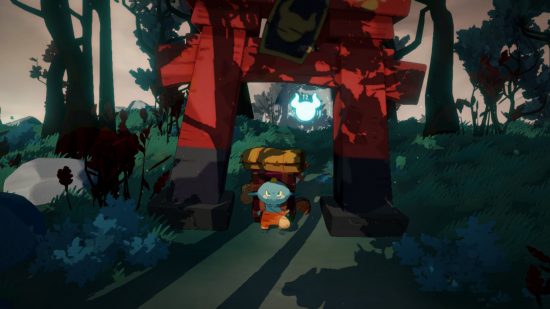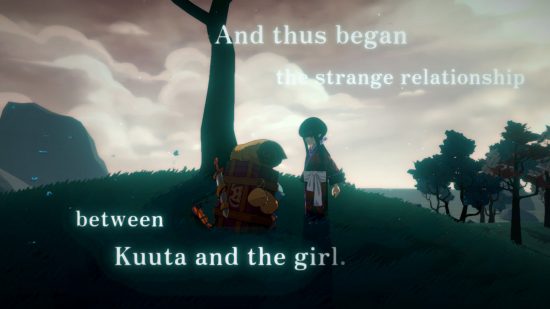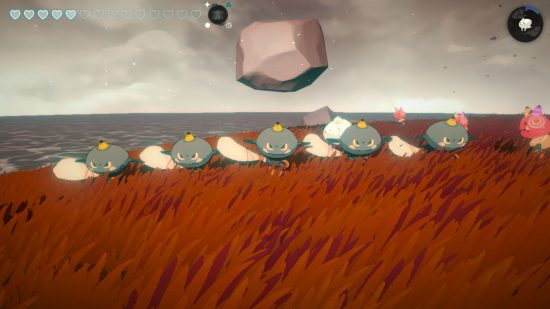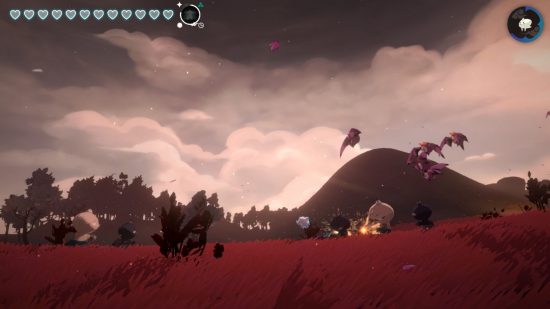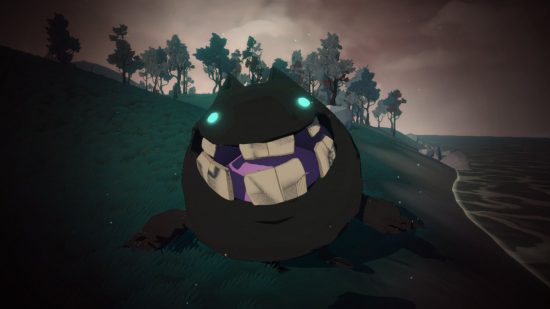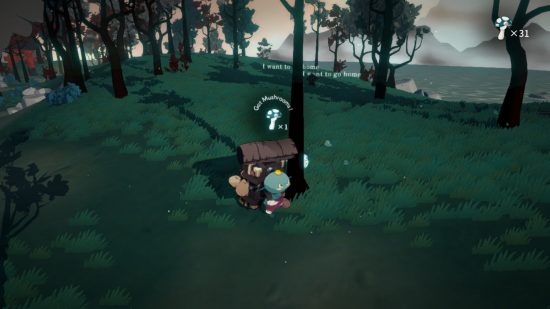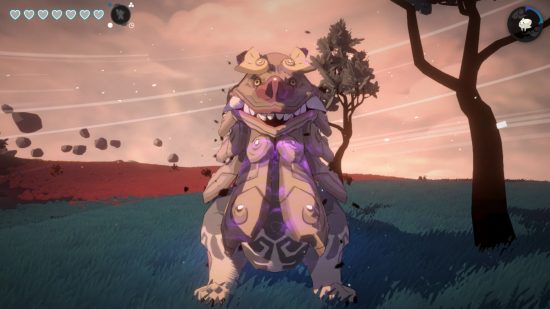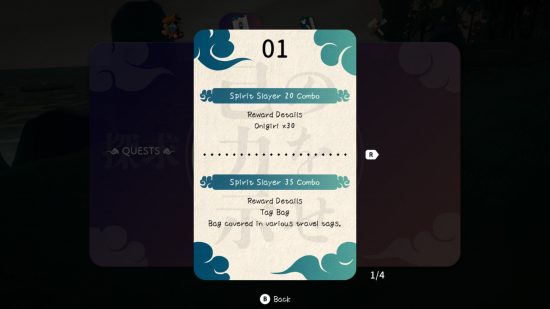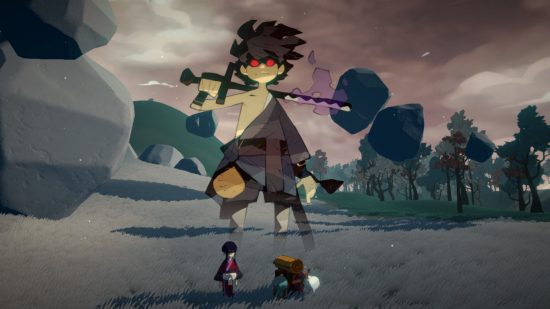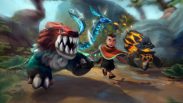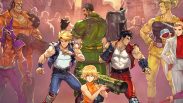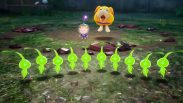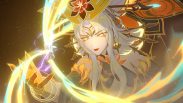I’ve long been fascinated with legends of oni and the tale of Momotaro, so upon seeing Oni: Road to be the Mightiest Oni and hearing of its unique take on Momotaro and his oni opponents, I knew I couldn’t let a peach like this pass me by. And, ultimately, I’m pleased to say this kibidango is just as delicious as I’d hoped, even if I couldn’t stop singing Wednesday Campanella’s Momotaro over and over in my head throughout my entire playthrough.
If you’re unfamiliar with Momotaro, in its simplest form, it’s an old Japanese story about a boy born from a peach who goes off to Onigashima (demon island) to fight a band of oni who ravaged his homeland, accompanied by a monkey, a dog, and a pheasant he meets along the way (who only help him in exchange for a taste of his yummy kibidango, of course).
However, in Oni: Road to be the Mightiest Oni it turns out that Momotaro, who is both human and evil monster, has been wreaking havoc among oni-kind. Demon warrior Kuuta and his new spirit pal Kazemaru set out on a quest to defeat Momotaro, but the road to be the mightiest oni is a long one indeed, and they need all the help they can get. As such, they must beat the demon spirits of Kisejima in a set of trials in order to harness their power. And guess what? You’re along for the ride.
The tale of Oni: Road to be the Mightiest Oni is a heartfelt twist on a classic tale, and carries a palpable sense of emotion throughout. This is especially present in the interactions between Kuuta and Kanna, the human girl he meets on the island. Historically, humans and oni have seen a great divide due to the conflicts between them. But, as you progress through the game, you watch the budding relationship between the two blossom into something beautiful, as Kanna slowly softens our proud little Kuuta’s heart, leading to some truly touching interactions between the two as they grapple with their own losses, beliefs, and purpose.
The game takes place on Kisejima, an isolated island in the middle of the ocean, where the ancient demons who were once defeated by Momotaro are lying dormant. You challenge these fallen demons through a series of trials that get progressively harder as you work your way through. In the trials, you get to make use of a variety of combat techniques to take down your foes.
You primarily control Kuuta, who is equipped with a club as his main weapon and can dodge roll quickly to avoid danger. You swing your club around by using the Y button until the soul of your enemy pops out, then you use A to destroy the soul before it returns to the body. If you manage to pull more than one soul out of an enemy at once, you can repeatedly press A to jump from soul to soul in rapid succession, triggering a combo in the process.
You also have a special move that charges up over time. To start, your special move is invincibility, which creates a soul blast around you and knocks enemies back, turning you invincible for a brief time. However, after completing the main boss battles, you unlock more special moves, such as the doppelganger technique, which allows you to create Kuuta clones to attack alongside you. I love that you can freely switch between your different special moves mid-battle by pressing the left and right directional buttons on your controller, and it becomes an interesting challenge to work out which special move is the most beneficial to your current situation.
You can also take control of Kazemaru by holding down the R shoulder button, which switches your right joystick from controlling the camera to controlling Kazemaru’s movement instead. While in control of Kazemaru, you can still move and attack with Kuuta, though your camera is dictated by where Kazemaru is. Kazemaru can travel a set distance from Kuuta, and also has multiple abilities for you to unlock. Your spirit pal has its own stamina meter. With enough stamina, Kazemaru allows you to pull the souls out of your enemies, can have Kuuta zip to its location through astral projection, and can even heal Kuuta for a portion of its stamina.
The combination of Kuuta and Kazemaru’s combat mechanics may sound complicated on paper, but you gain access to them at a steady pace, making it much easier to adapt, and I find the control layout to be comfortable and intuitive. These mechanics also keep the gameplay feeling fresh, as each challenge tasks you to use your arsenal of skills in new ways. As you progress, you also gain access to the wandering merchant Zenisuke’s shop, where you can purchase items in exchange for the mushrooms you find around the island. Zenisuke’s stock grows as you unlock new areas, allowing you to purchase health restorative items (kibidango and onigiri), powerful new weapons, and adorable little pants that come with different bonuses, such as increasing your health and speed.
The combat mechanics aren’t the only thing that keeps the combat feeling fresh, though. The trials take on a variety of different forms and perspectives, switching fluently between different playstyles throughout the trials by clever use of its viewpoints. In one trial, you may be taking down enemies in classic, third-person action combat. In the next, you may find yourself in a side-scrolling beat-em-up, then onto a taste of top-down bullet hell-esque chaos. This could be disorientating if implemented poorly, but it really works here and keeps the trials feeling fresh throughout. I really enjoy the variety in the different challenges and the comfortable lull of exploring the (predominantly) safe island between battles.
I say ‘predominantly’, because there is some threat outside of the trials. Throughout the game, you’re tasked with saving lost spirits and returning them to statues at your three bases in exchange for more hearts (which equates to a larger HP pool). To locate them, you must keep an eye on the top-right corner of your screen, where an indicator pops up when you’re close to a spirit. Then you need to use your little spirit pal’s vision by hitting ZR to reveal the spirit, and send it out to grab it. When you’ve got the spirit in tow, you just need to return it to one of the statues – simple, right? So where’s the threat?
Well, there are large, beastly demons that aren’t keen on you guiding those poor, lost spirits back to safety, and set out to snatch them from you. Kuuta can’t fight outside of the trials, so instead, you find yourself locked into a chase sequence, where you must run, dodge, and dive to the statue without getting caught. If you pass a shrine, you gain a brief moment of invisibility and shake the demons off your tail – unfortunately, this doesn’t last long.
Luckily, you also collect decoy dolls from chests around the island. If you have a decoy doll on you when the demon swipes at you, it pinches one of those instead of your little lost lamb of a spirit. To be honest, I never actually ended up losing a spirit to one of these demons, but every time I make the journey back to the statue and see that dark shadow encompass my screen, I find myself getting antsy, and that sense of tension certainly livens up the hunt for all 56 spirits.
Aside from that, the overall island is safe to explore. It’s all one map, but initially there are invisible walls sectioning it off into three parts. Once you’ve completed all the trials for each section, the invisible wall blocking the next area disappears. This pushes you to explore the island more thoroughly between trials and, as the island as a whole isn’t very big, you end up very familiar with its layout. Despite its small size, Kisejima still takes some time to traverse due to Kuuta’s slow waddle. Luckily, you also befriend a sweet little boar as you progress through the second part of the island. You can call your boar at any time by pressing the X button, then hop on its back to get around faster.
After combing every square inch of Kisejima in search of hidden treasures and repeatedly proving myself to be the embodiment of an ecological disaster as I pluck every fresh mushroom on respawn, I feel I’ve come to know the island better than my own house – and that’s not a complaint. Kisejima is beautiful, and I actually feel this small but densely packed environment works way better than a vast, empty open world in this situation, and it feels very rewarding to set out in search of those juicy mushrooms, scraps of lore, and more.
The music of Oni: Road to be the Mightiest Oni is very unique. Unlike most games of its style, it doesn’t have a classic instrumental soundtrack, instead opting for a mixture of lo-fi-esque electro-bops and soulful ballads. The songs are very emotive and fit well with the themes of the game, though I admit that the ballad that plays in the opening area started to grate on me after a certain amount of loops, leading me to feel that something without lyrics would have been a better choice for the main exploration sections of the game.
Luckily, there are plenty of other tracks for you to enjoy as you flick through menus, take on trials, and continue exploring new areas of the island. Plus, if you’re not vibing with the music but still want sound, there is a separate BGM slider in the options menu – though, of course, this does mute all background music, even in cutscenes, which feels quite a loss because there are some truly great tracks throughout the game.
Oni: Road to be the Mightiest Oni’s artstyle is absolutely beautiful, and fits the game wonderfully. Kuuta and Kazemaru are truly adorable, and Kanna’s design feels very graceful and ethereal, like a stylised modern take on a classic illustration. This is amplified in the Kuuta and Kanna cutscenes, where images appear in the sky to illustrate the stories they tell each other, and lines of text fade in around them like a children’s picture book. As mentioned above, Kisejima is also a really stunning environment to explore, with a nice variety of muted colours and textures that make you feel as though you’re journeying through all four seasons in the span of one small island.
There’s also a healthy variety of enemies in the game with some truly unique designs. From the little oni that look similar to our sweet Kuuta, to the intimidating bosses, they all fit in with the world perfectly while still giving you a pleasant surprise whenever you encounter a new foe.
When it comes to difficulty, Oni: Road to be the Mightiest Oni certainly has its tricky moments, but nothing you can’t overcome by familiarising the combat mechanics for both your characters and the enemies you’re fighting. However, I find the protect Zenisuke missions to be the most difficult, far moreso than even the bosses – primarily because the little chap seems to have a passion for running between club-wielding demons and standing there completely dumbfounded as he gets smacked around. But honestly, ‘protect the NPC’ missions are never a favourite of mine.
In terms of performance, Oni: Road to be the Mightiest Oni runs well on the Switch for the most part, and looks good in both handheld and docked modes. There is a certain amount of shadow and texture popping, but nothing too egregious. However, I did encounter a few performance issues such as framerate drops during specific special moves and busy battles with multiple enemies, though these weren’t a frequent occurrence.
I also experienced two game-breaking bugs. The first happened when a flying enemy froze high up in the air and I couldn’t reach it, preventing me from progressing in the trial, and resulting in me having to quit the game and start the trial over. The second was during a boss battle, after the enemy did a special move. At the end of the move’s animation, the whole game froze, and I once again had to quit the game and relaunch. Luckily, the autosave is frequent and reliable, and you can manually save at the statues, so I didn’t lose much progress. Plus, the load times are very quick, so it never takes me long to get back into the game. Nonetheless, these hiccups are quite frustrating, and I sincerely hope that Kenei Design and Shueisha Games manage to patch them out in the game’s full launch.
I completed the game, including all of the seal book’s side missions, in about 12 hours. To be honest, I was quite ill while playing, and was a little too frivolous with my mushroom funds, meaning I spent a lot of time deforesting (de-fungi-ing?) in order to afford all the items in the shop, so I believe you could likely finish the game in ten hours or less if you’re more on the ball than I was. I do feel that this is the perfect length for the game, though – it doesn’t overstay its welcome, but offers some nice challenges for the completionists out there, such as collecting all spirits, pants, and weapons, and finding certain hidden items and locations. You can also repeat trials to get faster times or higher combo scores if you so wish.
Overall, Oni: Road to be the Mightiest Oni is a heartfelt experience that offers a fresh take on a classic tale. Its unique combat, ambitious variety of gameplay styles, striking world, and emotional narrative unite to bring you along on a truly memorable journey, and you can feel the love and attention to detail poured into every pixel. Unfortunately, the Switch version is let down by some performance issues, but I still thoroughly enjoyed my time in Kisejima, and I highly recommend any aspiring oni looking for a classic action adventure game with a twist to give it a try.
If you’re already on the road to being the mightiest oni, you should check out the other titles featured on our lists of the best mobile adventure games and the best Switch adventure games. Or, if you’re looking to embark on a different kind of adventure, head over to our list of the best anime games on Switch and mobile.
Oni: Road to be the Mightiest Oni Switch review
Oni: Road to be the Mightiest Oni is a stunning adventure that offers a fresh twist on a classic story. Though the Switch version’s performance suffers some stutters, the unique combat, great range of challenges, and truly emotive narrative ensure that the touching tale of Kuuta and Kazemaru will stay with you for a long time.
